Perched dramatically on a bluff overlooking the Colorado River stands one of Arizona’s most iconic historic landmarks—Yuma Territorial Prison State Historic Park. This former frontier penitentiary, often nicknamed the “Hellhole of the West,” operated for just 33 years from 1876 to 1909, yet it holds a captivating place in Arizona’s territorial history as one of the Yuma Crossing and Associated Sites on the National Register of Historic Places in the Yuma Crossing National Heritage Area.
The prison’s strategic location, just three miles west of where the Colorado and Gila Rivers meet, speaks to Yuma’s historical significance as a crossing point that witnessed Fernando de Alarcon accompanying Coronado in 1540, Padre Kino in 1683, and countless gold rush immigrants crossing by ferry on their way to California in 1849. This convergence of waterways made Yuma an important transit point and eventually necessitated law enforcement facilities as the population grew.
During its operation, a total of 3,069 prisoners, including 29 women, lived within these walls. Their crimes ranged from murder to polygamy, with grand larceny being the most common offense. Today, visitors can walk through the actual strap iron cells and solitary chamber where these inmates once served their sentences, experiencing a tangible connection to Arizona’s territorial past.
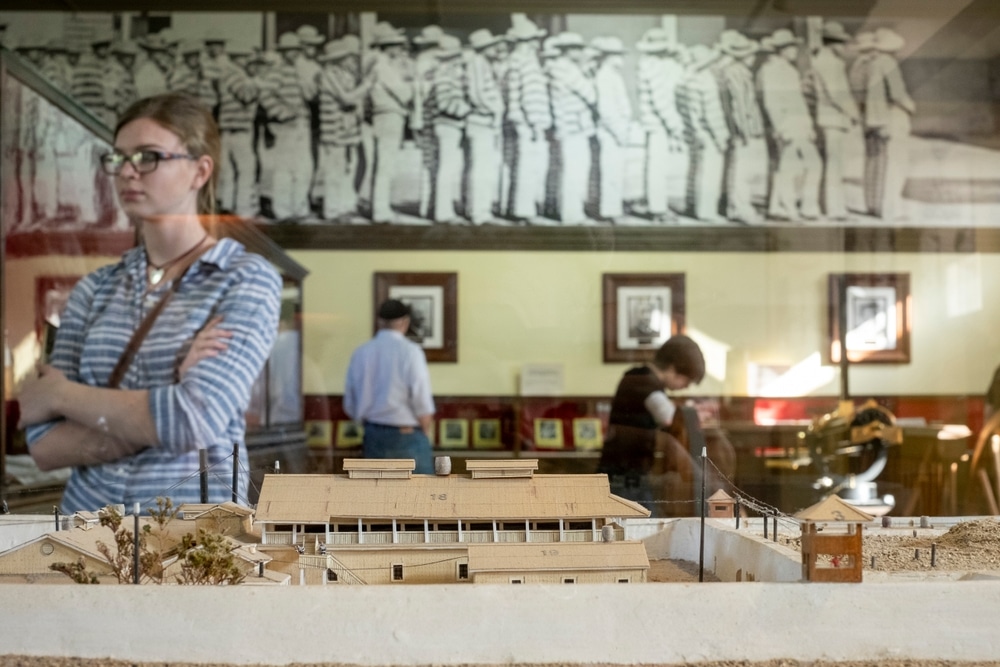
The prison’s significance extends beyond its role as a penal institution. It represents a crucial chapter in Yuma’s development and Arizona’s journey to statehood. After its closure as a prison, the structures served multiple community purposes—housing a high school, functioning as a hospital, and even providing shelter to homeless families during the Great Depression. This adaptability reflects the resilience and resourcefulness that characterized frontier communities.
As one of Arizona’s most visited historic attractions, the prison now invites visitors to step back in time and explore the complex stories of law, order, and life in the American Southwest during the territorial period. Voted as USA Today’s “Best Haunted Destination in the U.S.,” the site appeals to both history enthusiasts and those intrigued by tales of the supernatural, making it a multifaceted cultural landmark that continues to captivate the public’s imagination.
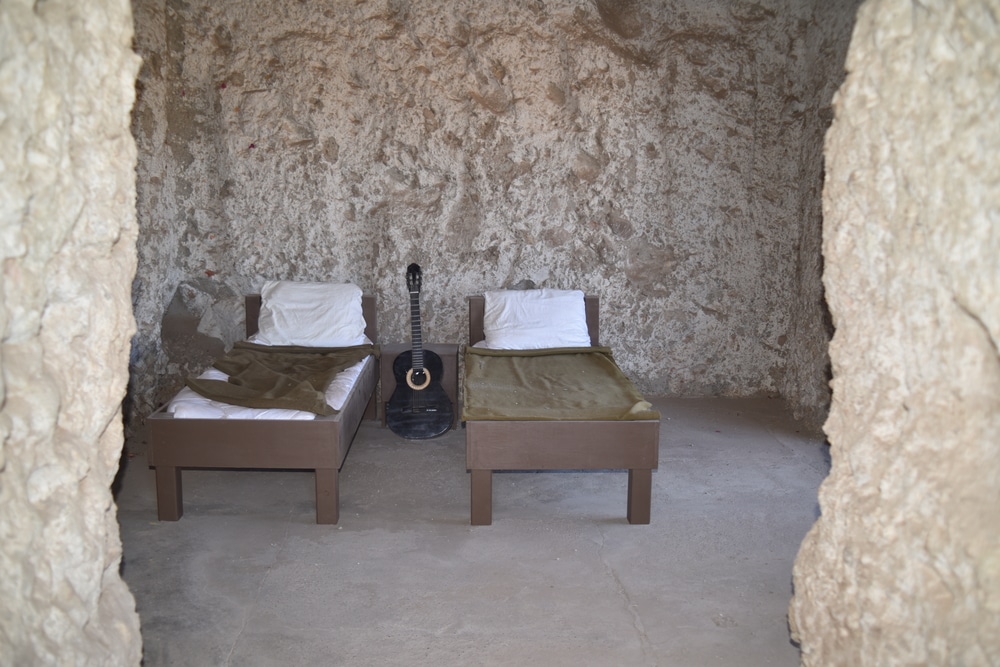
Operated from 1876 to 1909, Yuma Territorial Prison housed over 3,000 prisoners during its 33 years as a functioning penitentiary. Despite its harsh reputation, the prison was actually considered progressive for its time, featuring electricity, a library, and forced education for illiterate inmates. The prison closed primarily due to overcrowding, with prisoners transferred to a new facility in Florence, Arizona.
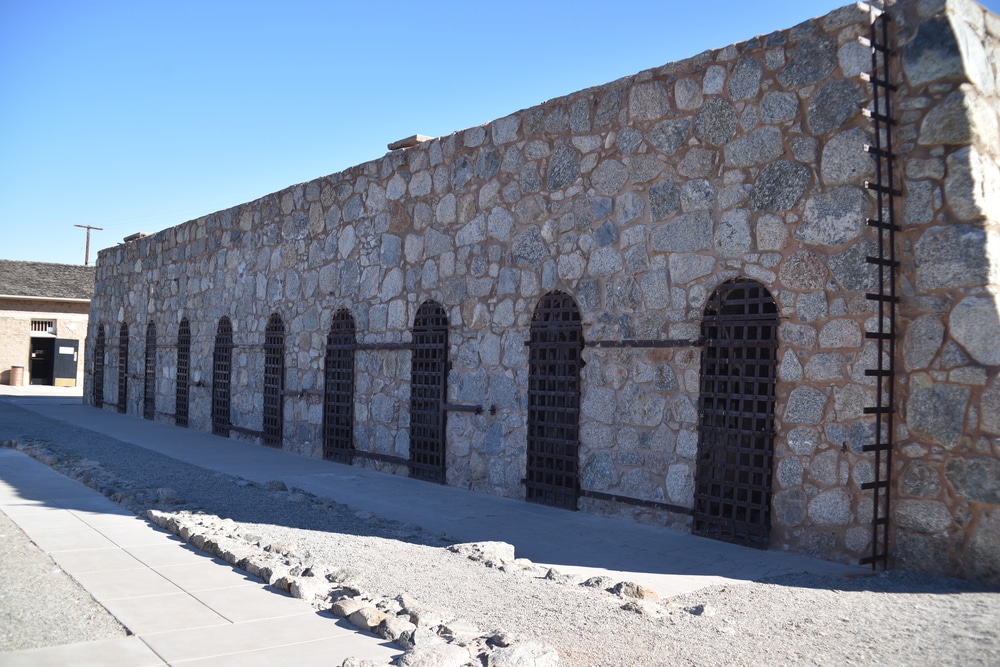
Visitors can explore the preserved cell blocks where prisoners were housed, including the infamous “dark cells” used for solitary confinement. The main cell block features the original iron cages where up to six prisoners shared a small space. The cells remain largely as they were, offering an authentic glimpse into 19th-century prison conditions.
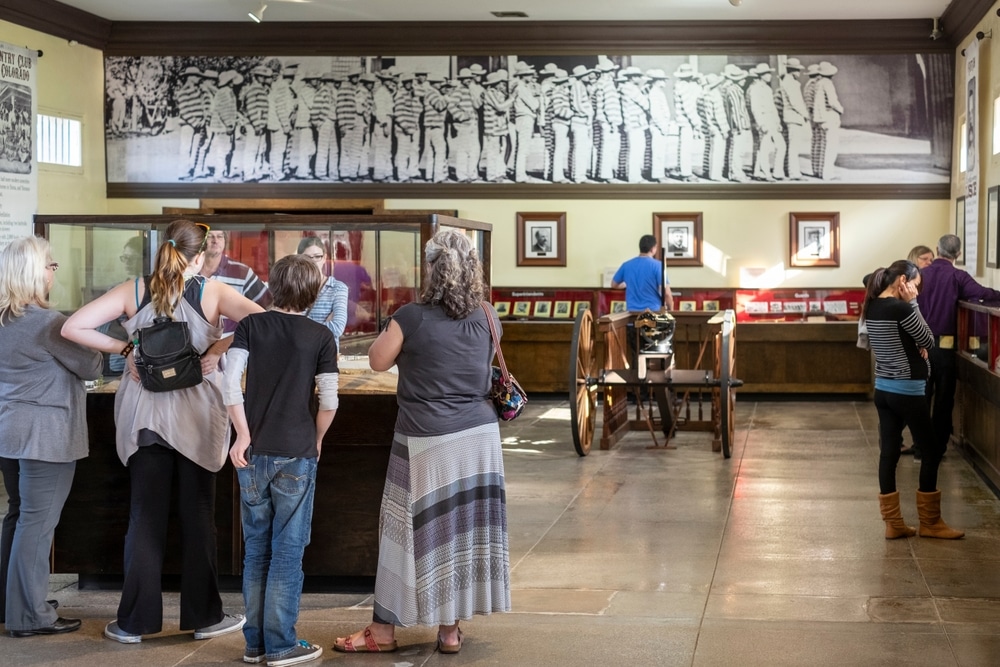
The prison’s museum houses an extensive collection of artifacts, including prisoner photographs, handmade weapons, uniforms, and personal effects. Interactive displays detail notable prisoners, escape attempts, and daily prison life. The museum also features the Gatling gun once used for perimeter security and various tools used by prisoners in the workshops.
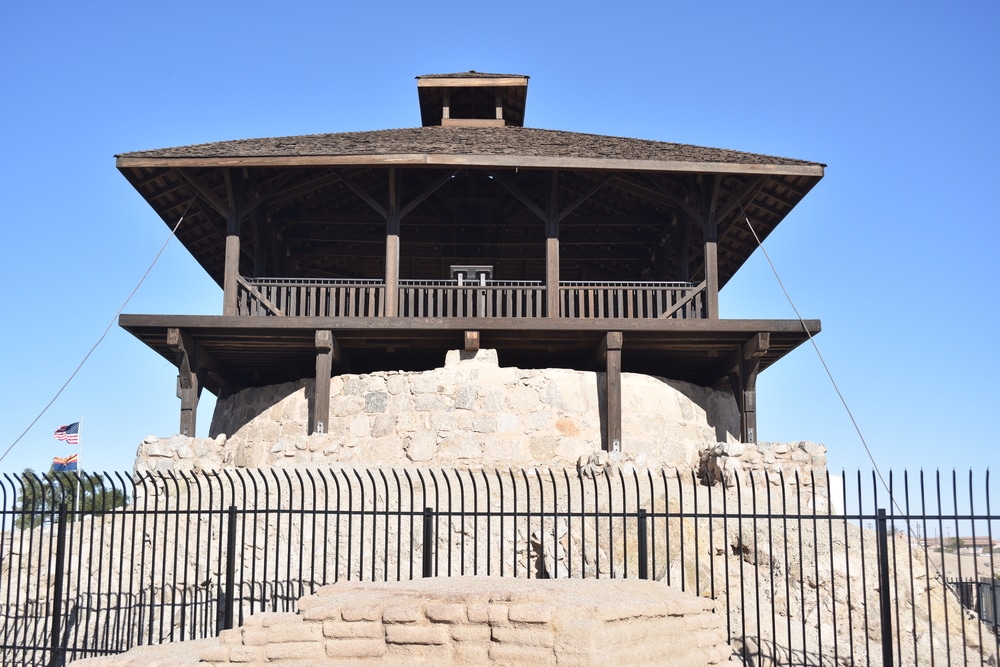
Climb the reconstructed guard tower for panoramic views of the Colorado River, prison grounds, and surrounding landscape. This vantage point helps visitors understand the prison’s strategic location on a bluff overlooking the river, which helped prevent escapes as the surrounding desert and river presented formidable natural barriers.
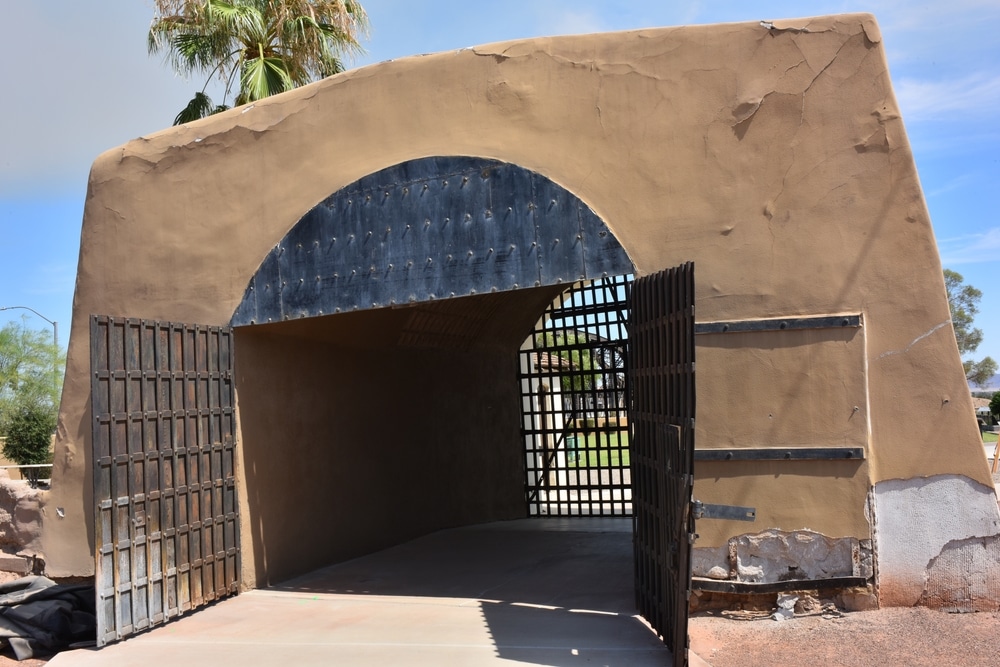
Examine the main entrance where all prisoners entered the facility. The sally port, with its massive iron gates and imposing stone architecture, symbolized the transition from freedom to incarceration. This area features interpretive displays about admission procedures and the psychological impact of imprisonment.
Self-guided tours form the backbone of the visitor experience. Guests can walk through the original cellblocks, peer into the infamous solitary confinement chamber known as the “Dark Cell,” explore the guard tower, and examine the sally port (the prison’s main entrance gate). Interpretive panels situated throughout the historic site provide context and bring to life the stories of those who lived and worked within these walls.
The museum housed in the visitor center contains a wealth of historical artifacts, photographs, and exhibits that chronicle the prison’s 33-year operation. One fascinating aspect highlighted in the museum is that the prison housed one of the first “public” libraries in the Arizona Territory, and fees charged to visitors for tours of the institution were used to purchase books. The museum also features displays about notable inmates, including the legendary stagecoach robber Pearl Hart.
Photography enthusiasts will find numerous compelling subjects at the park. The dramatic desert light, particularly during morning and evening golden hours, creates striking opportunities to capture the weathered stone walls, iron cell doors, and panoramic views of the Colorado River. The guard tower offers 360-degree views of Yuma and the surrounding landscape, making it a favored spot for photographers.
While the prison itself doesn’t offer water activities, its location provides excellent views of the Colorado River, where visitors can observe recreational boating and other water sports. The park’s proximity to Gateway Park and the Yuma Crossing National Heritage Area means that visitors can easily combine their prison tour with riverside recreation.
For those interested in hiking, the park includes a nature trail that allows visitors to explore the surrounding terrain while learning about both the natural environment and historical context. This trail is generally considered easy to moderate in difficulty and provides an opportunity to appreciate the desert landscape.
Picnic areas with a view of California across the river provide pleasant spots for a meal or snack break during your visit. These shaded areas offer a welcome respite from the Arizona sun, especially during the warmer months.
Stargazing can be remarkable in this desert region, though the park’s location within Yuma means some light pollution. Special nighttime events are occasionally held at the prison, offering a completely different perspective on the historic site under the desert sky.
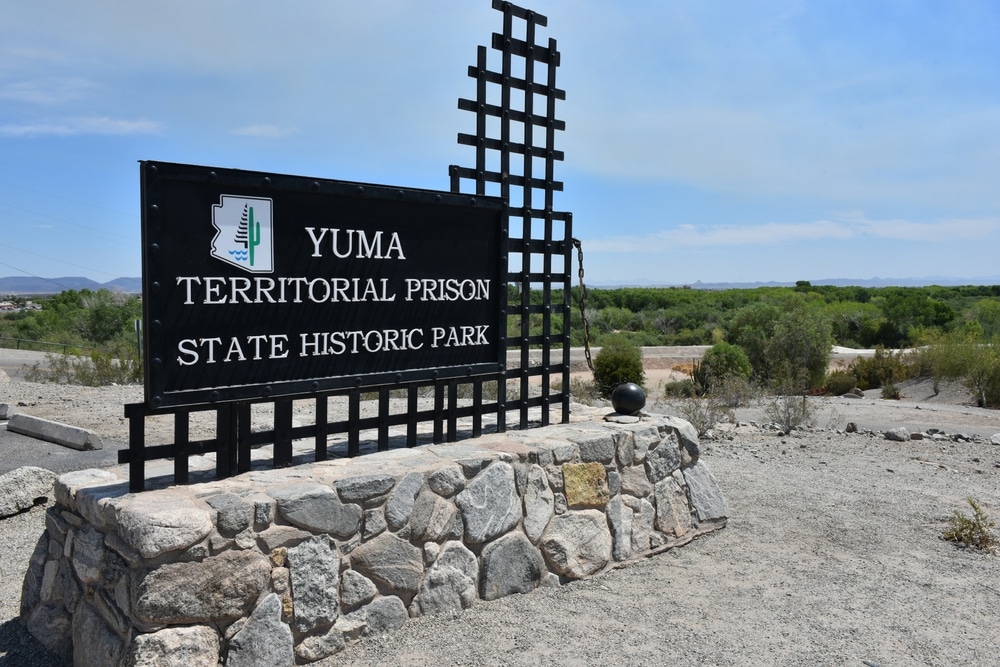
| Feature | Details |
|---|---|
| Location | Yuma, Arizona (overlooking the Colorado River) |
| Operated as Prison | 1876-1909 |
| Established as Park | 1961 |
| Nickname | “Hell Hole” |
| Historical Significance | Arizona’s first prison facility |
| Notable Features | Cell blocks, guard tower, solitary confinement (“Dark Cell”) |
| Number of Prisoners | Approximately 3,069 during operation |
| Construction | Built by prison labor using native materials |
| Museum | Exhibits of prison artifacts, photographs, prisoner records |
| Preserved Areas | Cell blocks, guard tower, sally port, prison cemetery |
| Cultural Reference | Featured in the film “3:10 to Yuma” |
| Famous Inmates | Pearl Hart (female stagecoach robber) |
| Visiting Hours | Daily (except major holidays) |
| Facilities | Visitor center, gift shop, interpretive displays |
| Ghost Stories | Reputed to be haunted by former prisoners |
Yuma Territorial Prison State Historic Park sits in a commanding position on Prison Hill, providing panoramic views of the surrounding landscape. The prison’s elevated location was strategically chosen both for security and to take advantage of the natural terrain. From this vantage point, visitors can see the original Ocean to Ocean highway bridge, a final link in the U.S. roadway system that connected the Atlantic and Pacific oceans, as well as the site of the first railroad bridge to span the Colorado River at Yuma Crossing.
The Colorado River, which flows past the prison grounds, has played a crucial role in shaping both the physical landscape and the human history of the region. This powerful waterway carved the terrain and created the bluff upon which the prison stands. In the late 19th century, when the prison operated, the river served as both a natural boundary and a vital transportation route. Today, the relationship between the historic site and the river continues to define the visitor experience.
The prison is situated in the heart of the Sonoran Desert, one of North America’s most ecologically diverse desert regions. The park sits at an elevation of 140 feet in an area characterized by extremely low relative humidity and very high summer temperatures. Average summer highs exceed 100 degrees Fahrenheit for four months of the year, while winter maximum temperatures typically range in the 60s and 70s. These harsh climatic conditions contributed to the prison’s reputation as a challenging place of confinement.
The geological composition of the area is predominantly sedimentary, with caliche (a hardened natural cement of calcium carbonate) forming much of the hill where the prison was constructed. This readily available material was used in the construction of prison facilities. Features like “caliche hill” remain visible at the site today, providing visitors with insight into how local geological resources were utilized.
The watershed of the region includes both the Colorado and Gila Rivers, which historically flooded seasonally before modern dam construction. These waterways created a riparian zone that contrasted sharply with the surrounding desert, offering vital resources to early inhabitants of the area. The prison’s proximity to these water sources was essential for its operation, providing water for drinking, sanitation, and limited irrigation.
The Yuma Territorial Prison State Historic Park is situated within the distinct ecosystem of the Sonoran Desert, home to some of the most resilient and specialized plant and animal species in North America. Though the prison grounds themselves are primarily developed as a historic site, the surrounding area showcases the rich biodiversity that characterizes this desert region.
The Sonoran Desert vegetation includes iconic species such as the saguaro cactus, ocotillo, creosote bush, palo verde, and mesquite trees. These drought-adapted plants employ various survival strategies to thrive in the arid environment. Many feature waxy coatings to reduce water loss, while others drop leaves during dry periods or grow only after seasonal rains. The prison’s location on a bluff overlooking the Colorado River means visitors can observe the contrast between desert vegetation and the more lush riparian plant communities along the riverbanks.
Wildlife in the vicinity of the park includes a diverse range of desert-adapted species. The area hosts numerous bird species, including the desert quail, Gambel’s quail, roadrunners, and various raptors that patrol the skies above the Colorado River. Mammals such as desert cottontails, jackrabbits, coyotes, and various rodent species inhabit the surrounding terrain, though they tend to be more active during cooler morning and evening hours.
Reptiles are particularly well-represented in the ecosystem around Yuma, with lizards such as the western whiptail and desert iguana being common sights during warmer months. Various snake species, including the western diamondback rattlesnake, also make their home in the region, having evolved specialized adaptations to survive the extreme desert conditions.
The seasonal cycles of the Sonoran Desert bring dramatic changes to the landscape. Following winter rains, typically from December through March, wildflowers can transform the apparently barren desert into a colorful display. Summer monsoons, generally occurring from July through September, trigger another growth cycle as desert plants respond quickly to the precious rainfall.
For visitors interested in experiencing more of the natural environment, the park includes a nature trail that allows for exploration of the local ecology while learning about the historic site. This trail offers opportunities to observe native plant species and potentially spot wildlife, particularly during the cooler hours of the day.
While Yuma Territorial Prison State Historic Park does not offer camping facilities within its boundaries, visitors to the area have a variety of accommodation options in and around Yuma. The historic prison is primarily a day-use facility focused on preserving and interpreting the site’s significant history rather than providing overnight stays.
For those seeking camping experiences in the vicinity, several options exist within a reasonable driving distance. The Colorado River area features multiple RV parks and campgrounds that cater to different preferences and needs. These facilities typically offer amenities such as electrical hookups, water access, shower facilities, and sometimes swimming pools to help combat the desert heat.
Private campgrounds in the Yuma area generally provide sites for both tent camping and RVs, with varying levels of service and amenities. Many of these are located along the Colorado River, offering pleasant water views and access to river recreation. Reservations are strongly recommended, especially during the winter months when Yuma’s population swells with seasonal visitors seeking the mild winter climate.
For visitors preferring hotel accommodations, Yuma offers a wide range of lodging options. The city hosts numerous chain hotels and motels, many concentrated along Interstate 8 for convenient access. These range from budget-friendly establishments to more upscale properties with full amenities.
Those interested in staying in historic accommodations might consider options in downtown Yuma, where buildings like The Lee Hotel, which dates to 1917, provide a connection to the era when the prison was in operation. These historic properties often combine period charm with modern conveniences.
For a more immersive experience, visitors might explore vacation rentals in the historic districts of Yuma, allowing for a neighborhood-based stay with kitchen facilities and more space than traditional hotel rooms. These can be particularly appealing for families or those planning extended visits to explore the area’s multiple historic sites.
When planning your visit, it’s worth noting that Yuma’s accommodation pricing follows seasonal patterns. The winter months (November through March) represent the high season when demand and prices peak due to the influx of winter visitors. Summer, despite the extreme heat, can offer significant savings for budget-conscious travelers willing to brave the higher temperatures.
While camping isn’t available at the prison site itself, its central location in Yuma means that visitors staying at any accommodation in the city can easily access the historic park as part of their exploration of the area’s rich cultural heritage.
To make the most of your trip to Yuma Territorial Prison State Historic Park, proper planning is essential. The park is open year-round but experiences significant seasonal variations in visitation and weather conditions that should factor into your preparations.
The park operates on a regular schedule, though hours may vary seasonally. The park is open from 9:30 a.m. to 5:00 p.m. during its standard operating season. Some sources indicate slightly different hours (8:30 a.m. to 4:00 p.m.), so it’s advisable to check the official Arizona State Parks website for the most current information before your visit.
Admission fees are approximately $10 per adult, with potential discounts for seniors, children, and military personnel. Annual passes to Arizona State Parks may provide a cost-effective option for those planning to visit multiple state parks during their Arizona travels.
Yuma’s climate plays a significant role in determining the optimal time for your visit. Yuma is one of the warmest and sunniest cities in the United States, with extremely low relative humidity and very high summer temperatures exceeding 100°F for four months of the year. Winter months offer much milder conditions, with average maximum temperatures in the 60s and 70s.
The most comfortable months for visiting are typically October through April, when temperatures are moderate and outdoor exploration is pleasant. Winter (December through February) represents the peak tourist season in Yuma, so expect larger crowds during this period. Summer visits, while challenging due to the extreme heat, offer the advantage of smaller crowds and potentially special programming.
Yuma receives less than 4 inches of precipitation annually, making rain rarely a concern for visitors. However, the desert sun and heat require preparation, particularly during summer months. Visitors should bring sun protection (hats, sunscreen, sunglasses), comfortable clothing, and adequate water, regardless of when they visit. The prison site offers limited shade, so be prepared for sun exposure during your tour.
The historic nature of the prison presents some inherent accessibility challenges, but efforts have been made to accommodate visitors with varying mobility needs. The park has modern, handicap accessible restrooms in the museum. Most of the main pathways are navigable for wheelchairs and mobility devices, though some areas of the historic prison, due to preservation requirements, may have limited accessibility.
As with most Arizona State Parks, leashed pets are generally permitted in outdoor areas but not inside buildings like the museum and visitor center. Service animals are allowed in all areas. Pet owners should be mindful of the hot ground temperatures that can harm animals’ paws, particularly during summer months.
Cell phone coverage is generally reliable throughout the park, as it is located within the city of Yuma. Most major carriers provide service in the area. Limited public Wi-Fi may be available in the visitor center, though connectivity in historic structures may be sporadic.
Yuma Territorial Prison State Historic Park offers visitors a range of facilities designed to enhance the educational experience while providing essential services. These amenities balance modern convenience with preservation of the site’s historic integrity.
The Visitor Center serves as the hub of the park experience, housing a gift shop, modern restrooms, and an introductory exhibit along with photographs that provide context for your exploration of the prison grounds. This climate-controlled space offers a welcome respite from the Arizona heat and serves as an orientation point for visitors beginning their tour.
Within the Visitor Center, the gift shop offers fun prison-themed merchandise including T-shirts, baseball caps, keychains, replica handcuffs, and books about the prison. These souvenirs provide a tangible memento of your visit while supporting ongoing preservation efforts at the historic site.
The museum, a centerpiece of the visitor experience, occupies 3,600 square feet and houses extensive exhibits chronicling the prison’s operations and the lives of those who were incarcerated there. Displays include artifacts, photographs, and interactive elements that bring the prison’s history to life. The museum’s exhibits explain how one of the early electrical generating plants in the West was utilized at the prison to furnish power for lights and run a ventilation system in the cell blocks, demonstrating the facility’s surprisingly advanced infrastructure for its era.
Throughout the grounds, interpretive panels provide information about key features including the original cellblocks, water tank, guard tower, sally port (entrance gate), library room, the dark cell, caliche hill, and the new yard and cells. These panels help visitors understand the significance of each area within the context of the prison’s operations.
For visitors seeking outdoor relaxation, picnic areas with tables and a ramada provide shaded spaces to rest and enjoy views of the Colorado River and California beyond. These areas are ideal for families or groups wanting to combine their historical exploration with a meal break.
Restroom facilities include modern, handicap accessible restrooms located in the museum, ensuring that visitors can comfortably spend extended time exploring the historic site. The accessibility of these facilities reflects Arizona State Parks’ commitment to accommodating visitors with diverse needs.
Water fountains are available in key locations, an important amenity given Yuma’s hot climate. Visitors are nonetheless encouraged to bring their own water bottles, particularly during summer months when staying hydrated is essential for comfort and safety.
While the prison itself doesn’t offer concessions or food service, its location in Yuma means that numerous dining options are available within a short drive. The nearby historic downtown area features restaurants, cafes, and markets where visitors can purchase meals or snacks before or after their prison tour.
Visitors to Yuma Territorial Prison State Historic Park will find themselves ideally positioned to explore numerous other attractions that showcase the region’s rich history, natural beauty, and cultural heritage. The prison’s central location makes it an excellent starting point for a more comprehensive exploration of Yuma and the surrounding area.
Just a short distance from the prison lies the Colorado River State Historic Park, located on the grounds of the 1864 U.S. Army Quartermaster Depot. This historic site illustrates how important Yuma and the Colorado River were to the development of the Southwest. Five original buildings remain on the depot grounds, with exhibits chronicling Arizona’s military history and the construction of major irrigation systems in the early 1900s. Visitors can learn how steamboats once used the river to deliver supplies to the Arizona Territory, complementing the frontier justice narrative presented at the prison.
Riverfront parks and walking trails connect the former prison grounds to Yuma’s historic downtown district, where visitors can see what life was like outside the prison walls during the city’s early years. The Sanguinetti House Museum & Gardens preserves the 19th-century adobe home of one of Yuma’s early business leaders, offering insight into the civilian side of frontier life.
Yuma’s historic district also features The Lee Hotel (dating to 1917), the Spanish Colonial Revival post office (dating to 1933), the Yuma Theatre, and the Kress Building—structures that operated during the prison’s heyday and now house restaurants, bars, and shops. These preserved buildings create an immersive historical experience that contextualizes the prison within broader community development.
For those interested in natural areas, several significant sites lie within driving distance of Yuma. These include the Imperial National Wildlife Refuge (40 miles north), Kofa National Wildlife Refuge (30 miles north), and the Muggins Mountains Wilderness (25 miles east). These protected lands offer opportunities for wildlife viewing, hiking, photography, and experiencing the diverse Sonoran Desert ecosystem.
Cultural attractions in the vicinity include Gateway Park, the Yuma Crossing National Heritage Area, and the Quechan Indian Museum in nearby Winterhaven, which provide insight into the indigenous history and cultural dimensions of the region. These sites help visitors understand the multilayered historical significance of the Yuma area beyond its frontier justice narrative.
For a more unusual heritage experience, the Castle Dome Mines Museum & Ghost Town (located within driving distance of Yuma) offers a glimpse into the mining history that played a crucial role in the development of the Arizona Territory. This open-air museum preserves structures and artifacts from a once-bustling mining community.
Agricultural tourism also flourishes in the Yuma area, with Martha’s Gardens Medjool Date Farm offering tours and tastings that showcase the region’s important agricultural history and innovations in desert farming techniques. These agricultural operations demonstrate how the water of the Colorado River transformed the desert into productive farmland.
The preservation of Yuma Territorial Prison as a historical landmark represents a significant conservation success story that spans nearly a century. What began as a neglected ruin has been transformed into one of Arizona’s most visited and valued historic parks, thanks to sustained community effort and institutional support.
The journey toward preservation began in the years following the prison’s 1909 closure. The first formal request to preserve the Prison came in the early 1930s, and by 1939, local residents had begun to raise funds for renovation of the guard tower and construction of a museum. This grassroots initiative demonstrated the community’s recognition of the site’s historical significance long before formal historic preservation programs were widely established.
The City of Yuma initially operated the museum and prison area until 1960. Following a process that resolved various land ownership issues, the City of Yuma sold the Territorial Prison to the Arizona State Parks Board for one dollar in October 1960. The Yuma Territorial Prison State Historic Park officially opened to the public on a limited basis on January 1, 1961, with Clarisa Windsor serving as the first park manager.
In more recent years, the park has faced funding challenges that threatened its continued operation. In 2010, after state budget cuts threatened closure of the park, the Yuma Crossing National Heritage Area stepped forward to save and manage the site on behalf of the City of Yuma. This arrangement was formalized in 2016 with a 15-year agreement between the City of Yuma and Arizona State Parks and Trails. This partnership model represents an innovative approach to heritage conservation that leverages the strengths of multiple stakeholders.
Ongoing conservation efforts at the prison focus on both structural preservation and interpretive development. Careful maintenance of the remaining historic structures—particularly the adobe sally port, which is the only original adobe structure remaining at the prison—requires specialized knowledge and techniques. Conservation work seeks to balance authentic presentation of the historic structures with visitor safety and accessibility requirements.
Beyond physical preservation, the park engages in educational stewardship through its museum exhibits, interpretive programs, and special events. These initiatives ensure that the stories associated with the prison—both the institutional narrative and the individual experiences of prisoners and staff—are preserved and communicated to future generations.
Visitors to the park play an important role in conservation through their adherence to responsible visitation practices. Guidelines typically encourage staying on designated paths, not removing artifacts or damaging structures, and respecting the site as both a historic resource and a place of remembrance for those who were imprisoned there.
Through excellent management and marketing, the Yuma Territorial Prison State Historic Park has more than doubled its revenues since 2010 and has developed a long-term capital improvement program. This financial sustainability is crucial for ensuring that conservation efforts can continue into the future, preserving this unique window into Arizona’s territorial period for generations to come.
The Yuma Territorial Prison State Historic Park stands as a compelling monument to Arizona’s frontier past. From its dramatic setting overlooking the Colorado River to its well-preserved cell blocks and engaging exhibits, the park offers visitors a multifaceted experience that combines historical education with appreciation of the unique desert environment.
As you plan your visit to this iconic landmark, consider how the prison fits within the broader context of Yuma’s development and the natural landscapes that shaped human experience in this challenging environment. Whether you’re a history enthusiast, a photography buff, or simply curious about life in the territorial Southwest, the prison park provides a memorable glimpse into a formative period of Arizona’s past.